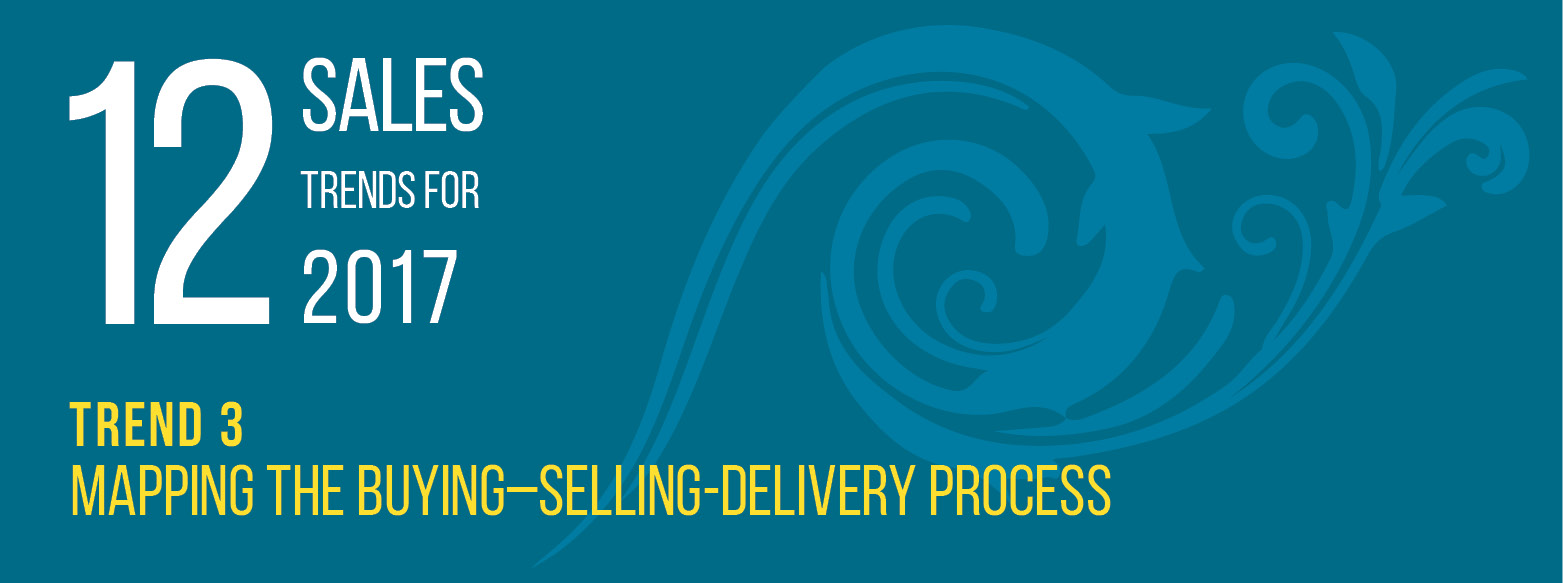
Sales Trend 3 from our 12 Sales Trends for 2017 report is Mapping the Buying-Selling-Delivery Process.
If you want your sales team and your business to move from ordinary to extraordinary when it comes to client engagement and better sales results, it pays to do what the smart companies are doing and map your entire buying-selling-delivery process—the client value chain—and make sure everyone in your organisation understands what it is, where they fit in and how they all support the buying-selling-delivery client experience.
Sales Trend 3 points out that in the hyper-competitive and transparent business world of today we need everyone in our organisation focused on delivering a consistent, safe and rewarding experience for our clients, based on the value proposition we promised them from the outset.
If we promise to deliver fast, efficient and easy service, or ROI and value based on evidence, ideas and innovation as part of a complex system for example, then everyone in our businesses needs to know what promises we are making and how we consistently deliver on these promises. This is how we can ensure our clients want to come back for more, or at the very least be happy to refer us to others.
No longer can the buying-selling-delivery process be passed off as someone else’s job—selling is now everybody’s business.
Research findings published by consulting and/or research firms like McKinsey[1] are showing that the buying-selling-delivery process—the client value chain—coupled with a client centric ethos based on a fair exchange of value needs to be embraced from the top all the way down and across the business if we want to attract, engage and retain good clients. This is not just a cultural ‘we are client-centric’ philosophy, this about actual behavioural activity standards that can be observed, trained and coached.
Highly competitive businesses such as Carsales.com.au have adopted a tribe structure ensuring that B2B clients are supported and managed by specific teams (tribes or squads) staffed by a range of people with specific capabilities that include account management and sales along with insights, production, product development and so on. The clients are at the centre of the tribe’s focus with everyone working towards delivering the right outcomes for their clients and the business. All of these people will interact in some way with the client on their buying and service delivery journey. All of these people have the opportunity to listen to the client, find the areas for improvement, spot the on-sell opportunities, fix the glitches, reduce wastage and so on. If everyone knows where they intersect on this buying-selling-delivery journey then they know what they are accountable for and how they help each other deliver the right outcomes as promised.
 To achieve this it means that the steps of the buying-selling-delivery process need to be mapped and articulated with specific activities that deliver the minimum standard of excellence deemed correct for the business’ sales strategy and the promises made to the clients in our value proposition.
To achieve this it means that the steps of the buying-selling-delivery process need to be mapped and articulated with specific activities that deliver the minimum standard of excellence deemed correct for the business’ sales strategy and the promises made to the clients in our value proposition.
We may be led to believe that big data, social selling and automation will take care of everything on the buyer’s journey but this is an over simplification of a non-linear process that has, at its heart, constant variability governed by ever-changing human and task needs.
Even if buyers are being more discerning and not engaging with us directly as early as they used to in the buying process, they still will come in contact with us once they are serious about buying and once they have bought. Selling doesn’t stop once a client buys, now the real business begins where the promises made are in play and the test is if it will be delivered. This sales trend sees smart businesses paying attention and equipping their teams to deliver on that promise across the value chain time and time again—this helps any business move from ordinary to extraordinary, and clients will pay attention and share the news of their great buying and service experiences.
Smart businesses know that you cannot do that without a road map of sorts. Without an articulated buying-selling-delivery process we cannot see, manage and engage with our buyers at the various touch points we have with, nor can we track the skills, tasks and activities necessary for effective client/buyer engagement.
The magic of an articulated buying-selling-delivery process is in the details; the myriad of little steps and actions that make for a great experience and great results—for both buyer and seller. The myriad of little interactions that could lead to the next sale and the one after that; or the small issue, if identified and acted upon quickly by alert and accountable team members, that can keep the client experience flowing positively, knowing that if issues do occur they are acknowledged and addressed quickly and without fuss.
Automation and effective use of CRM can play key roles in a fuss free client experience but in and of themselves will not be the silver bullet solution you can rely upon.
Unless your offering is very simple and can be automated completely to remove humans (which we haven’t found yet), then someone somewhere needs to support the buying-selling-delivery experience in your organisation. Who will that be in your case?
Smart companies have realised that if they want to move from ordinary to extraordinary they need to make it easy for buyers to buy and experience a streamlined, fuss free delivery process by getting everyone in their organisation focused on consistent execution across the client value chain. Nothing is left to chance when you know what you are doing and you do it well.
Remember everybody lives by selling something.
Author: Sue Barrett, www.barrett.com.au
[1] https://www.mckinsey.com/business-functions/marketing-and-sales/our-insights/do-you-really-understand-how-your-business-customers-buy


New Article Email Notification